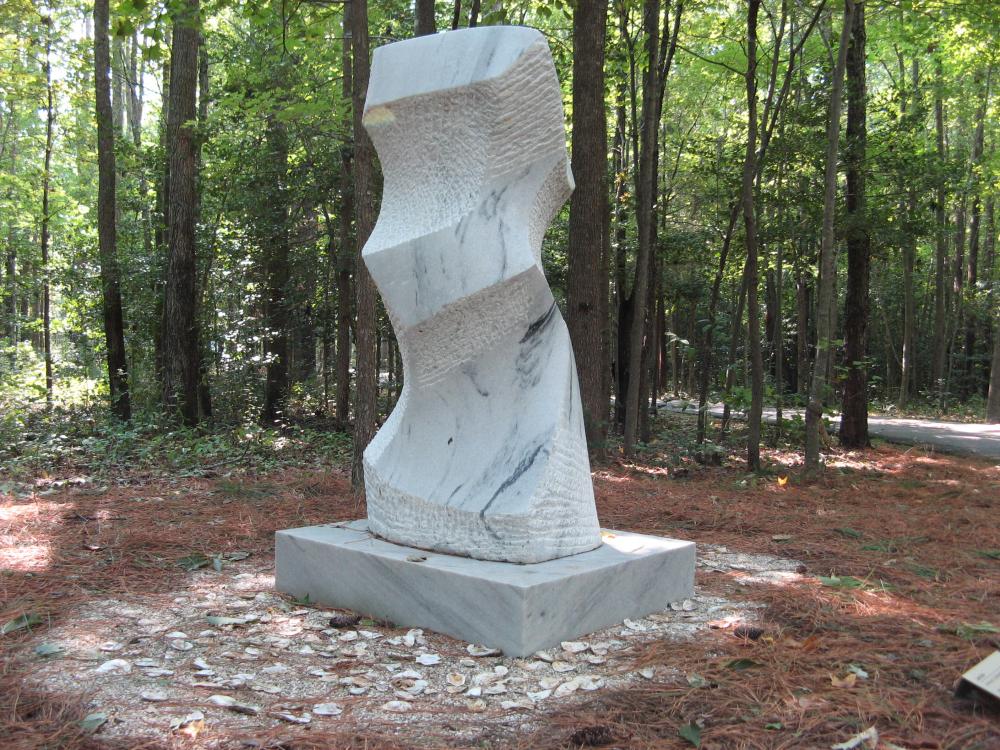|
 
 
|
Works currently on loan from the Hirshhorn Museum & Sculpture Garden
|
|

|
Marseille
1960 (cast 1963)
Bronze
Cèsar
French, b. Marseilles, 1921-1998
Hirshhorn Museum and Sculpture Garden, Smithsonian Institution, Gift of Joseph H. Hirshhorn, 1966
Perhaps because of an early life spent in the poverty of an Italian neighborhood in Marseilles, César felt more at home in the industrial setting of a scrap yard than in an artist's studio. Primarily concerned with abstract forms, he turned to cheap scrap metal to create his often provocative art. The shape of Marseille, named for the seaport town where he was born, is suggestive of the sail of a boat in the harbor. Tiny shells and other coastal debris appear imbedded in the heart of the sail. The original Marseille, in the collection of the Hirshhorn, consists of numerous pieces of welded scrap metal. This bronze was made from a mold of the original and bears the evidence of its ancestry of welded steel construction.
|
|

|
Castle of the Eye
1975
Carrara marble, with granite base
Minoru Niizuma
American, b. Tokyo, Japan, 1930-1998
Hirshhorn Museum and Sculpture Garden, Smithsonian Institution, Gift of the artist, 1976
|
|

|
Standing Nude
Date unknown
Bronze
Nelli Bar
American, b. Cologne, Germany, 1904 - 2001
Hirshhorn Museum and Sculpture Garden, Smithsonian Institution, Gift of Joseph H. Hirshhorn, 1966
|
|

|
After Iyengar
1978
Bronze
Robert Engman
American, b. Pennsylvania 1927
Hirshhorn Museum and Sculpture Garden, Smithsonian Institution, Gift of Joseph H. Hirshhorn, 1979
Named after the Indian Yoga master B.K.S. Iyengar, the sculpture has been carefully placed at the intersection of two of the Garden’s long grassy hallways. Visitors have commented that the work appears to be an optical puzzle because from each new vantage point new shapes appear. Its wonderfully dynamic geometric form twists together circles and a square to create an Escher-like quality to the bronze.
|
|

|
The Bird, Uranus II
1957
Bronze
Etienne Hajdu
French, b. Romania, 1907-1996
Hirshhorn Museum and Sculpture Garden, Smithsonian Institution, Gift of Joseph H. Hirshhorn, 1966
Of Hungarian descent, Hajdu moved to Paris in 1927, where he studied classical sculpture and painting. He quickly developed an interest in contemporary art and launched himself into the study of figurative and abstract sculpture. Self taught, he worked with a variety of materials including slate, aluminum, copper, bronze, marble and onyx. He continued to draw which allowed him the opportunity to experiment with light and space. The Bird, an excellent example of his work, demonstrates the smooth and elegant form of his sculptures. The shape of the piece and the web-like pattern of lines suggest a creature poised to take flight.
|
|

|
Curved Form: Bryher II
1961
Bronze
Dame Barbara Hepworth
British, b. Wakefield, England, 1903-1975
Hirshhorn Museum and Sculpture Garden, Smithsonian Institution, The Joseph H. Hirshhorn Bequest, 1981
|
 |
Girl With Braids
1950
Bronze
Gerhard Marcks
German, b. Berlin, 1889-1981
Hirshhorn Museum and Sculpture Garden, Smithsonian Institution, Gift of Joseph H. Hirshhorn, 1966
Marcks, primarily recognized as a sculptor, was also a talented ceramicist and designer. His work was banned by the Nazis during World War II. The many pieces he had stored in his studio were destroyed in bombing raids and those he had secretly hidden were plundered and ruined. After the war, he was commissioned to create numerous memorials and public monuments across Germany. In his ceramics and woodcuts, his sculptural techniques are recognizable in the classic figures and crisp lines. Girl With Braids, exemplifies Marcks' ability to create a clean modern look in the face and form, yet convey a complex emotional statement.
|
|

|
Monumental Standing Cardinal
1958
Bronze
Giacomo Manzu
Italian, b. Bergamo, 1908-1991
Hirshhorn Museum and Sculpture Garden, Smithsonian Institution, Gift of Joseph H. Hirshhorn, 1966
Manzu grew up immersed in the imagery and patriarchy of Italian Catholicism which is reflected in much of his art. Beginning in the late 1930s and continuing for several decades, he produced numerous works featuring standing and seated cardinals. Monumental Standing Cardinal is not intended to portray a specific person, but rather to convey the strength and authority of the church and its centuries long history. The sculpture is classic in its subject and posture, yet possesses a modern approach to the expression. Note the curious transformation from the wood-like base to the metal sculpture. Set amidst the tall trees of Annmarie Garden, the Cardinal is part of nature's cathedral.
|
 |
Torso
Date unknown
Bronze
Frederick Charles Shrady
American, b. Eastview, New York, 1907 - 1990
Hirshhorn Museum and Sculpture Garden, Smithsonian Institution, Gift of Joseph H. Hirshhorn, 1980
|
|

|
Greenberg Variations
1974
Cor-ten Steel
Jules Olitski
American, b. Snovsk, Russia, 1922
Hirshhorn Museum and Sculpture Garden, Smithsonian Institution, Museum Purchase 1977
|
 |
Resting
1965
Bronze
Paul Suttman
American, b. Enid, Oklahoma, 1933-1993
Hirshhorn Museum and Sculpture Garden, Smithsonian Institution, Gift of Joseph H. Hirshhorn, 1972
|
|

|
The Wind: Stainless Steel Monument
1966
Stainless Steel
Attilio Pierelli
Hirshhorn Museum and Sculpture Garden, Smithsonian Institution, Gift of Joesph H. Hirshhorn, 1980
|
|

|
Six Number Two
1967
Stainless steel with wire cable
Kenneth Snelson
American, b. Pendleton, Oregon, 1927
Hirshhorn Museum and Sculpture Garden, Smithsonian Institution, Gift of Joseph H. Hirshhorn, 1980
Snelson relies on the opposing forces of tension and compression, a relationship he terms "tensegrity," to lend stability and strength to his creations. Fascinated by the structure of weaving patterns and the structure of the atom, his work reflects his appreciation for the complex network of forces that comprise the universe. Six Number Two, like his other pieces appears rather delicate, but is surprisingly strong. Snelson's work is noted for this apparent contradiction; they appear precarious, yet the use of modern materials coupled with his precise designs results in an elegantly sturdy structure.
"The wires and metal tubes are my keyboard, on which I play my three-dimensional spatial game. It's like playing a violin." - Kenneth Snelson
|
|

|
Circular Reflection
1972
Painted steel
Yehiel Shemi
Israel, b. Haifa, 1922
Hirshhorn Museum and Sculpture Garden, Smithsonian Institution, Gift of Joseph H. Hirshhorn, 1980
Shemi created his first pieces in stone and wood while living on a kibbutz in Israel. Employed as a construction worker on the kibbutz, he began to create abstract works using industrial tools and scrap materials. In Circular Reflection, a fine example of his work, the smaller of the two round elements was cut from the larger, resulting in a self-reflective component to the piece. The large, angled armature lends balance and stability to the overall structure. As the structure is viewed from different vantage points, interesting shadows and shapes appear and disappear, like the changing reflection of a moving object.
|
 |
Big Skull II
Bronze
Jack Zajac
American, b. Youngstown, Ohio 1929
Hirshhorn Museum and Sculpture Garden, Smithsonian Institution, Gift of Joseph H Hirshhorn, 1966
|
|

|
Daimaru X
1978
Steel
Michael Todd
American, b. Omaha, Nebraska, 1935
Hirshhorn Museum and Sculpture Garden, Smithsonian Institution, by exchange from Michael Todd, Los Angeles, January 15, 1980
|
|

|
Seated Woman
1975
Bronze
Francisco Zúñiga
Mexican, b. San Jose, Costa Rica, 1913 - 1998
Hirshhorn Museum and Sculpture Garden, Smithsonian Institution, The Joseph H. Hirshhorn Bequest, 1981
|
 |
Traveler's Column 1962
Bronze
Arnoldo Pomodoro
Italian, b. Marciano, 1926
Hirshhorn Museum and Sculpture Garden, Smithsonian Institution, Gift of Joseph Hirshhorn, 1966
|
|
Works Formerly on loan to Annmarie from the Smithsonian Institution:
|
|
|

|
Dragan
1973-1974
laminated acrylic
Vasa Velizar Michich
American, b. Yugoslavia
Hirshhorn Museum and Sculpture Garden, Smithsonian Institution, Gift of Mr. & Mrs. Frederick R. Weisman, Beverly Hills, CA, 1974
|
|

|
Open Suspense
1968
Cor-ten steel
Menashe Kadishman
Israeli, b. Tel Aviv, 1932
Hirshhorn Museum and Sculpture Garden, Smithsonian Institution, Gift of Joseph H. Hirshhorn, 1972
The top two elements of this work, a rectangle and a half ring, seem gently balanced on top, in opposition to its massive cor-ten steel construction. Looking down the hallway from Open Suspense, the visitor is afforded a spectacular view of After Iyengar.
|
 |
Isaac Witkin
Hirshhorn Museum and Sculpture Garden,
Smithsonian Institution
|
|

|
Squatting Woman with Shawl
1971
Bronze
Francisco Zúñiga
Mexican, b. San Jose, Costa Rica, 1913 - 1998
Hirshhorn Museum and Sculpture Garden, Smithsonian Institution, Gift of José Tasende, 1976
|
 |
Shembo
1983
Welded steel
James Wolfe
American, b. New York City, 1944
Hirshhorn Museum and Sculpture Garden, Smithsonian
Institution, Purchased from James Wolfe, New York, 1984
|
Works currently on loan from the National Gallery of Art
|
 |
Cluster of Four Cubes
1992
Stainless steel
George Rickey
American, 1907-2002
National Gallery of Art, Gift of George Rickey and Patrons' Permanent Fund
|
 |
Untitled
model 1971, fabricated 1977
aluminum, painted
James Rosati
American, 1912-1998
National Gallery of Art, Gift of the Collectors Committee based on a model given by the artist in memory of William C. Seitz
|
 |
Oriforme
model 1962, fabricated 1977
Stainless steel
Jean Arp
French, born Germany (Alsace), 1886-1966
National Gallery of Art, To the American People in Gratitude - Leon Chalette, Arthur Lejwa and Madeleine Chalette Lejwa
|
Works currently on loan to Annmarie from Private Collections
|
|

|
Potomac Rhythm
1979
Georgia Marble
Lee Aks
American, b. Bethesda, Maryland, 1946
On loan from the artist
For years, Aks’ piece, Potomac Rhythm, sat in a back lobby of the Torpedo Factory in Alexandria, Virginia, but at Annmarie Garden it has been given a setting worthy of its form. Carved from a several thousand pound chunk of white Georgia marble, his piece undulates like a flowing river. The combination of multiplying ripples and smooth satiny surfaces embodies the varying nature of the Potomac River. Set amid a leafy backdrop, the black-veined white marble glows under the sheltering tree canopy.
|
|

|
Equation
1999
Bronze
Andrew Baxter
American, b. New York City, 1957
On loan from the artist
Baxter’s shield-like bronze piece called Equation sits propped on a tripod in the woods, as if the artist imagines the work as a bronze painting. Indeed, Baxter is known as a superb conservator able to create luminous patinas on old bronze sculpture. With Equation he has “painted” his bronze with the loveliest brown and copper tones. Baxter is fascinated with the idea of infinity and imagines his work as a depiction of something at the microscopic level, a limitless world where time and space meld.
|
Works formerly on loan to Annmarie from Private Collections
|
|
 |
Auspicious Triple Sheep
2013
Baked enamel on steel plates, integral granite base
Hung Yi
Taiwanese, b. Taichung, 1970
On loan from Insian Gallery
|
 |
|
Sun Burst II
2020
Downspouts, elbows, automotive paint
Jean Jinho Kim (show in photo)
Cumberland, Maryland
On loan from the artist
This work is for sale; please inquire at the Murray Arts Building
|
|
|
|
|
|
|
|
|
|
|
|
|
|

